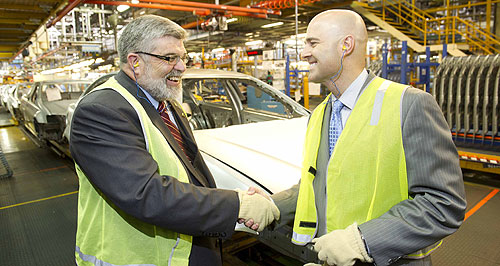Make / Model Search
News - General News - RegulationMore green car grants in the pipelineShake on it: Innovation and industry minister Senator Kim Carr with Holden managing director Mike Devereux at the Elizabeth in Adelaide. ‘Significant’ federal grants still to come from defunct Green Car Fund, says Carr20 May 2011 THE federal government’s announcement yesterday of a $39.8 million grant to GM Holden for its next generation Commodore will not be the last handout from Canberra’s Green Car Innovation Fund (GCIF), with innovation and industry minister Kim Carr confirming that “significant” projects are still in the pipeline. Senator Carr told GoAuto his department had not processed all remaining applications lodged before the fund was closed off in late January, and he was confident that “a few more grants” would be announced. “Not all the programs have been rolled out yet, but we have committed about $500 million,” he said. “How much we end up spending depends on some of the assessments still to be done. “Remember, there is a pretty stiff assessment process, so we have got a few more grants to be announced and a few more applications to be fully processed.” So far, the government has announced about $340 million in grants from the fund, which when released in 2008 was meant to provide $1.3 billion in assistance to the motor industry over 12 years. Since then, however, the government has progressively removed chunks to pay for other programs.  Left: An employee at Holden's Elizabeth plant in South Australia. Left: An employee at Holden's Elizabeth plant in South Australia.The fund was axed in late January to help cover the damage bill from the Queensland floods, but Senator Carr promised that pending applications received at that time would still be processed. Potentially, a further $140 million could be dished out if approved grants for applications still in limbo took the total to the $500 million ceiling mentioned by Senator Carr. The Labor Senator said the GCIF program had been be based on a one-dollar-for-every-three-dollars basis, but so far had generated more investment than that, with companies tipping extra on many projects. “The advice I am getting is we have attracted $2 billion in extra investment, leveraged off that (GCIF grants),” he said. “We produced much better than the three-to-one that we set out in the initial program objectives.” Senator Carr hinted that investment in engine fuel economy improvements might be among projects yet to be unveiled. “The most significant technological breakthroughs to changes to fuel consumption and tailpipe emissions will come through improvements to the internal combustion engine,” he said. “There’s LPG provisions, there’s more efficient petrol systems as well, but it is quite a diverse approach to improving fuel economy and improving tailpipe emissions.” Senator Carr said the federal government was funding about five projects researching electrification for cars, including battery research and the electric Commodore concept being built by a consortium of local automotive suppliers EV Engineering. But he said new projects for mass-produced hybrid vehicles in Australia beyond the Toyota Camry Hybrid were up to the individual car-makers. “The new (Holden) Cruze will have electric capability, but all of that will depend on the business case for the future,” he said. “We are trying to build platforms that are flexible and versatile and can meet changing market conditions. At the end of the day, there is a critical factor in all of this is: who is going to buy the vehicle at a price the companies can afford to build.” While in Adelaide for the Holden grant announcement yesterday, Senator Carr also visited automotive mirror maker SMR Automotive which has already received a $2.5 million GCIF grant to produce mirrors that are more fuel efficient for cars of tomorrow. Senator Carr revealed that the mirrors – developed in conjunction with the University of South Australia and the CSIRO – are made of plastic, using polymers which are claimed to perform better than the original glass mirrors. He said the project had the potential to generate strong international markets for Australia through SMR, which is owned by an Indian company. “That is very, very important in terms of our links into the Indian supply chain, as well as the United States,” he said. The grant to SMR Automotive will help to fund a new clean production room for the hi-tech process. Also among South Australian companies to get grants yesterday were Numetric Manufacturing, of Wingfield, which received $287,000 towards new machinery to make engine mounts for Toyota’s next generation Camry Hybrid. The company is the supplier of cast iron engine mounts for the Australian-made Camry and Aurion, and it expects to produce up to 135,000 units a year for Toyota’s factory in Altona, Victoria, once the new model is up and running from late this year.  Read more |
Click to shareGeneral News articlesResearch General News Motor industry news |










Facebook Twitter Instagram